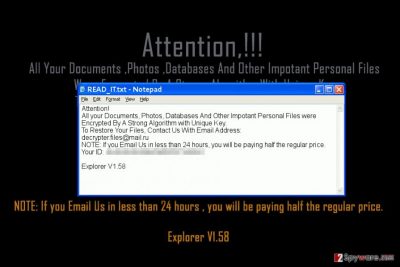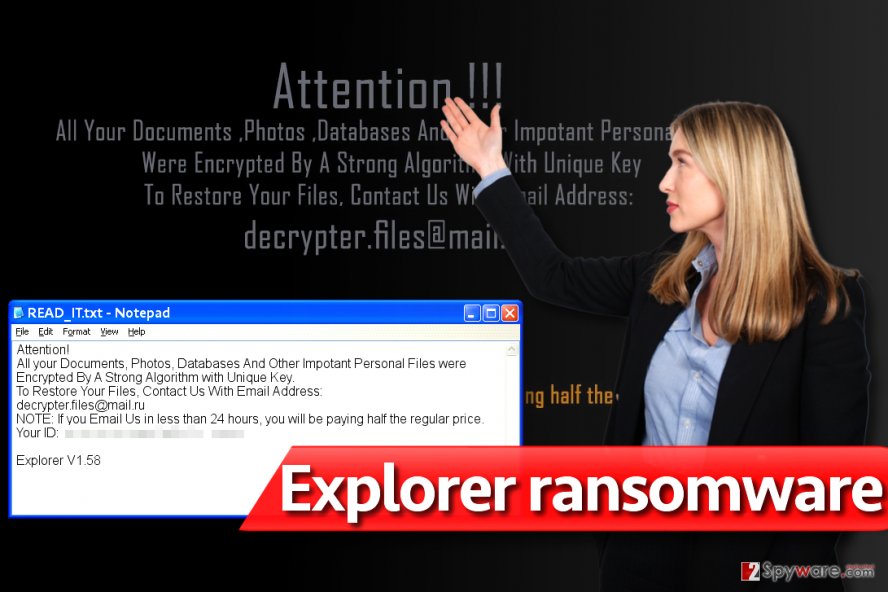Explorer ransomware / virus (Virus Removal Guide) - Quick Decryption Solution
Explorer virus Removal Guide
What is Explorer ransomware virus?
Explorer ransomware is a file-encrypting Trojan that demands ransom

Explorer ransomware is a computer virus that encrypts files with a strong algorithm and prevents the user from accessing them. Each encrypted file gets an additional .explorer extension. In the ransom note called READ_IT.txt, the virus presents itself as Explorer V1.58.
The ransomware[1] approaches the victim as an explerer.exe file, which, once executed, start encrypting victim’s photos, videos, databases, and videos with AES algorithm. Then it creates a ransom note that contains victim’s ID and a suggestion to write to decrypter.files@mail.ru.
The virus doesn’t state how much money it wants to receive from the victim in exchange for data decryptor, although usually, such viruses ask for $200-$1000 in Bitcoin. Developers of this particular ransomware claim that if the victim contacts them within 24 hours, one needs to pay only half of the ransom price.
Explorer virus is created using an open-source code of HiddenTear ransomware[2]. It means that victims might be introduced to a free data recovery tool quite shortly. Until then, you must remove Explorer ransomware from the system.
It is not advisable to use a compromised computer because the ransomware may have additional features such as keylogging. If you care about your privacy, run a full system scan right now to delete the virus from the system.
Ransomware is not a typical computer program, and you won’t be able to complete Explorer removal manually. If course, if you are an experienced IT expert, your attempts might be successful. However, each ransomware sample is different and dangerous in its own way.
Therefore, we believe that using a security software developed by malware analysts is the best idea. Besides, such software cleans all spyware and malware from the system, leaving it clean and safe-to-use. Researchers from LesVirus.fr[3] suggest applying several layers of protection (creating data backup, using anti-malware software, installing regular software updates) to ward of ransomware in the future.

Keep ransomware viruses away from your computer
To keep ransomware at bay, you need to follow certain rules. Methods used to distribute ransomware are quite basic, and cyber criminals introduce new techniques very rarely.
In our opinion, even inexperienced computer users can easily keep up with the latest malware distribution trends. Knowledge about them is what helps to keep unwanted software at bay. However, you should also follow these tips.
- First of all, you can avoid ransomware simply by deleting suspicious emails from your Inbox. Do not let eye-catching subjects convince you to open them or files attached to them.
- Second, enable automatic updates to keep all of your programs up-to-date. The outdated software contains security vulnerabilities that criminals can easily exploit.
- Third, avoid visiting suspicious websites or downloading illegal software. These two are the top sources of malware.
- Finally, create a data backup and use a trustworthy security software to ward unwanted programs off your computer.
Remove Explorer ransomware
It is a must to remove Explorer virus because there is no reason for keeping it on your computer system. What is even more important, you shouldn’t pay the ransom as it does not guarantee data recovery. We do not think that sending money to cybercriminals is a good idea because frauds can invest that money in further illegal projects.
We suggest that you make Explorer ransomware removal your top to-do task. With the help of tutorial that we provided, you can complete this task today. Do not forget to choose anti-spyware or anti-malware software that you want to use first. Do not attempt to uninstall the ransomware manually because you can never know what files or programs it dropped on your PC.
Getting rid of Explorer virus. Follow these steps
Manual removal using Safe Mode
Remove Explorer ransomware using these instructions. First of all, you will need to restart your computer and run it in a Safe Mode with Networking.
Important! →
Manual removal guide might be too complicated for regular computer users. It requires advanced IT knowledge to be performed correctly (if vital system files are removed or damaged, it might result in full Windows compromise), and it also might take hours to complete. Therefore, we highly advise using the automatic method provided above instead.
Step 1. Access Safe Mode with Networking
Manual malware removal should be best performed in the Safe Mode environment.
Windows 7 / Vista / XP
- Click Start > Shutdown > Restart > OK.
- When your computer becomes active, start pressing F8 button (if that does not work, try F2, F12, Del, etc. – it all depends on your motherboard model) multiple times until you see the Advanced Boot Options window.
- Select Safe Mode with Networking from the list.

Windows 10 / Windows 8
- Right-click on Start button and select Settings.

- Scroll down to pick Update & Security.

- On the left side of the window, pick Recovery.
- Now scroll down to find Advanced Startup section.
- Click Restart now.

- Select Troubleshoot.

- Go to Advanced options.

- Select Startup Settings.

- Press Restart.
- Now press 5 or click 5) Enable Safe Mode with Networking.

Step 2. Shut down suspicious processes
Windows Task Manager is a useful tool that shows all the processes running in the background. If malware is running a process, you need to shut it down:
- Press Ctrl + Shift + Esc on your keyboard to open Windows Task Manager.
- Click on More details.

- Scroll down to Background processes section, and look for anything suspicious.
- Right-click and select Open file location.

- Go back to the process, right-click and pick End Task.

- Delete the contents of the malicious folder.
Step 3. Check program Startup
- Press Ctrl + Shift + Esc on your keyboard to open Windows Task Manager.
- Go to Startup tab.
- Right-click on the suspicious program and pick Disable.

Step 4. Delete virus files
Malware-related files can be found in various places within your computer. Here are instructions that could help you find them:
- Type in Disk Cleanup in Windows search and press Enter.

- Select the drive you want to clean (C: is your main drive by default and is likely to be the one that has malicious files in).
- Scroll through the Files to delete list and select the following:
Temporary Internet Files
Downloads
Recycle Bin
Temporary files - Pick Clean up system files.

- You can also look for other malicious files hidden in the following folders (type these entries in Windows Search and press Enter):
%AppData%
%LocalAppData%
%ProgramData%
%WinDir%
After you are finished, reboot the PC in normal mode.
Remove Explorer using System Restore
-
Step 1: Reboot your computer to Safe Mode with Command Prompt
Windows 7 / Vista / XP- Click Start → Shutdown → Restart → OK.
- When your computer becomes active, start pressing F8 multiple times until you see the Advanced Boot Options window.
-
Select Command Prompt from the list

Windows 10 / Windows 8- Press the Power button at the Windows login screen. Now press and hold Shift, which is on your keyboard, and click Restart..
- Now select Troubleshoot → Advanced options → Startup Settings and finally press Restart.
-
Once your computer becomes active, select Enable Safe Mode with Command Prompt in Startup Settings window.

-
Step 2: Restore your system files and settings
-
Once the Command Prompt window shows up, enter cd restore and click Enter.

-
Now type rstrui.exe and press Enter again..

-
When a new window shows up, click Next and select your restore point that is prior the infiltration of Explorer. After doing that, click Next.


-
Now click Yes to start system restore.

-
Once the Command Prompt window shows up, enter cd restore and click Enter.
Bonus: Recover your data
Guide which is presented above is supposed to help you remove Explorer from your computer. To recover your encrypted files, we recommend using a detailed guide prepared by 2-spyware.com security experts.Speaking of data recovery options, we must say that they are very limited. You either need to have a data backup or use methods provided below. Remember that data backup ensures recovery of the majority of files, meanwhile third-party tools can be less powerful.
If your files are encrypted by Explorer, you can use several methods to restore them:
Restore files in Data Recovery Pro way
Data Recovery Pro software can be used to restore part of the encrypted data. The guide provided below explains how to use this system tool.
- Download Data Recovery Pro;
- Follow the steps of Data Recovery Setup and install the program on your computer;
- Launch it and scan your computer for files encrypted by Explorer ransomware;
- Restore them.
Recover files with Volume Shadow Copies
Volume Shadow Copies can be used for data recovery. Unfortunately, ransomware viruses tend to delete them. If Explorer malware left them on your system, run ShadowExplorer software to take advantage of them.
- Download Shadow Explorer (http://shadowexplorer.com/);
- Follow a Shadow Explorer Setup Wizard and install this application on your computer;
- Launch the program and go through the drop down menu on the top left corner to select the disk of your encrypted data. Check what folders are there;
- Right-click on the folder you want to restore and select “Export”. You can also select where you want it to be stored.
Finally, you should always think about the protection of crypto-ransomwares. In order to protect your computer from Explorer and other ransomwares, use a reputable anti-spyware, such as FortectIntego, SpyHunter 5Combo Cleaner or Malwarebytes
How to prevent from getting ransomware
Do not let government spy on you
The government has many issues in regards to tracking users' data and spying on citizens, so you should take this into consideration and learn more about shady information gathering practices. Avoid any unwanted government tracking or spying by going totally anonymous on the internet.
You can choose a different location when you go online and access any material you want without particular content restrictions. You can easily enjoy internet connection without any risks of being hacked by using Private Internet Access VPN.
Control the information that can be accessed by government any other unwanted party and surf online without being spied on. Even if you are not involved in illegal activities or trust your selection of services, platforms, be suspicious for your own security and take precautionary measures by using the VPN service.
Backup files for the later use, in case of the malware attack
Computer users can suffer from data losses due to cyber infections or their own faulty doings. Ransomware can encrypt and hold files hostage, while unforeseen power cuts might cause a loss of important documents. If you have proper up-to-date backups, you can easily recover after such an incident and get back to work. It is also equally important to update backups on a regular basis so that the newest information remains intact – you can set this process to be performed automatically.
When you have the previous version of every important document or project you can avoid frustration and breakdowns. It comes in handy when malware strikes out of nowhere. Use Data Recovery Pro for the data restoration process.
- ^ Alfred Ng. The global ransomware epidemic is just getting started. CNET News - Technology News. Top Technology News, with Investigative Reporting and In-Depth Coverage of Tech Issues and Events.
- ^ Hidden Tear Project: Forbidden Fruit Is the Sweetest. Tripwire - The State of Security. IT Security News & Blog.
- ^ LesVirus. LesVirus. Malware Removal Tutorials, Cyber Security Tips & Tricks.





















